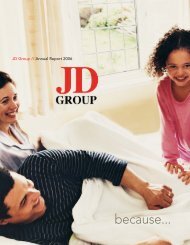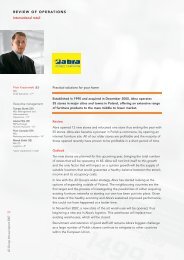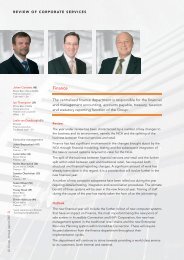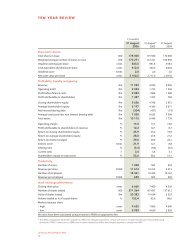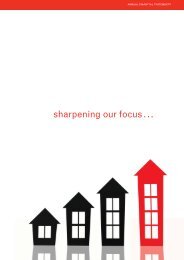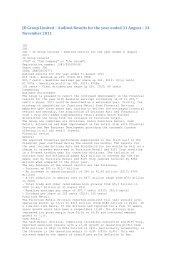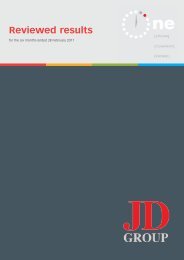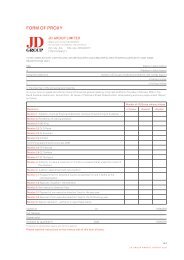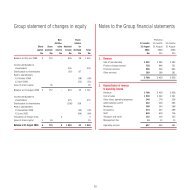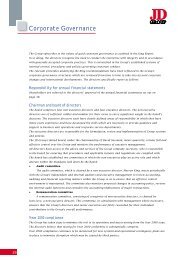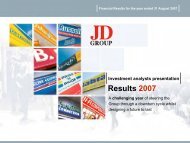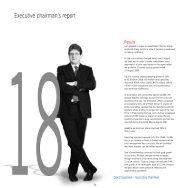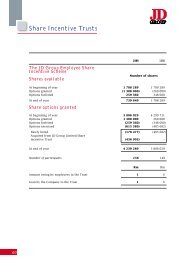Annual Report - JD Group
Annual Report - JD Group
Annual Report - JD Group
You also want an ePaper? Increase the reach of your titles
YUMPU automatically turns print PDFs into web optimized ePapers that Google loves.
Accounting policies continued<br />
Provisions<br />
Provisions are recognised when the <strong>Group</strong> has a present,<br />
constructive or legal obligation as a result of a past event and it is<br />
probable that it will result in an outflow of economic benefits that<br />
can be reasonably estimated.<br />
An onerous contract is a contract under which the unavoidable<br />
costs of meeting the obligation exceeds the economic benefit<br />
expected to be received under it. When a contract becomes<br />
onerous, the present obligation under a contract is recognised and<br />
measured as a provision.<br />
If the effect is material, provisions are determined by discounting<br />
the expected future cash flows that reflect current market<br />
assessments of the time value of money and, where appropriate,<br />
the risks specific to the liability.<br />
Cash and cash equivalents<br />
For the purposes of the cash flow statement, cash and cash<br />
equivalents comprise cash on hand and deposits held on call with<br />
banks and investment banks, net of bank overdrafts. In the<br />
balance sheet, bank overdrafts are included in current liabilities.<br />
Treasury shares<br />
Shares purchased by wholly owned <strong>Group</strong> companies in their<br />
holding company and by the employee share trusts are classified<br />
as treasury shares, held at cost and presented in equity.<br />
Dividends received on treasury shares are eliminated on<br />
consolidation.<br />
Treasury shares are taken into account in the calculation of<br />
earnings per share.<br />
Discontinued operations<br />
A discontinued operation is a significant distinguishable component<br />
of the <strong>Group</strong>’s business that is abandoned or terminated pursuant<br />
to a single formal plan, and which represents a separate major line<br />
of business or a geographical area of operation.<br />
The profit or loss on sale or abandonment of a discontinued<br />
operation is determined from the formalised discontinuance date.<br />
Borrowing costs<br />
Borrowing costs directly attributable to the acquisition,<br />
construction or production of qualifying assets (i.e. assets that<br />
necessarily take a substantial period of time to get ready for their<br />
intended use or sale) are capitalised as part of the cost of those<br />
26<br />
assets. The capitalisation rate applied is the weighted average of<br />
the net borrowing costs applicable to the net borrowings of the<br />
Company. Capitalisation of such borrowing costs ceases when the<br />
assets are substantially ready for their intended use or sale.<br />
Investment income earned on the temporary investment of<br />
specific borrowings pending their expenditure on qualifying assets<br />
is deducted from borrowing costs capitalised.<br />
All other borrowing costs are expensed in the period in which they<br />
are incurred.<br />
Exceptional items<br />
All items of income and expense are taken into account in arriving<br />
at income before taxation. Where items of income and expense<br />
are of such size, nature or incidence that their disclosure is relevant<br />
to explain the performance of the <strong>Group</strong> or Company, they are<br />
separately disclosed and appropriate explanations are provided.<br />
Research and development costs<br />
Research costs are recognised as an expense in the period in which<br />
they are incurred.<br />
Expenditure on development is charged to income in the year in<br />
which it is incurred except where a clearly defined project is<br />
undertaken and it is reasonably anticipated that development<br />
costs will be recovered through future commercial activity. Such<br />
development costs are capitalised as an intangible asset and<br />
amortised on a straight line basis over the life of the project from<br />
the date of commencement of commercial operation.<br />
Property, plant and equipment<br />
Property, plant and equipment is stated at cost and is depreciated<br />
on the straight line basis over the estimated useful lives of the<br />
assets concerned. Rates of depreciation vary between 10% and<br />
33,3% per annum and are disclosed in note 9.<br />
Surplus or loss arising on disposal of assets is determined as the<br />
difference between the sale proceeds and carrying value of the<br />
asset and is recognised in the income statement.<br />
Leased assets<br />
Lease agreements which transfer substantially all the risks and<br />
rewards associated with ownership of an asset to the lessee are<br />
regarded as finance leases. Assets subject to finance lease<br />
agreements are capitalised at the lower of the present value of<br />
the minimum lease payment and their cash cost equivalent and<br />
the corresponding liability to the lessor is raised. Lease payments




